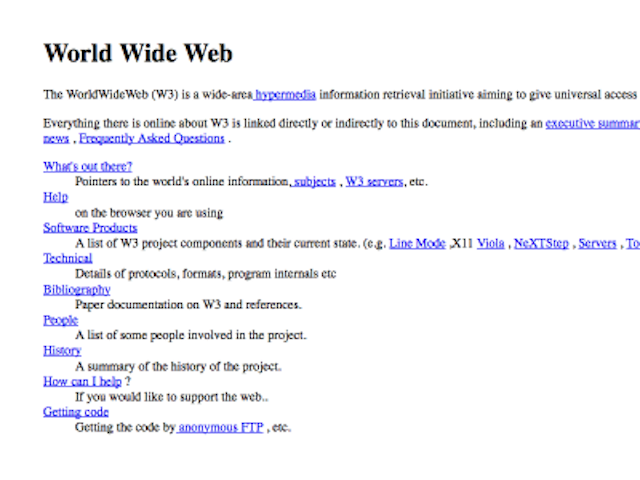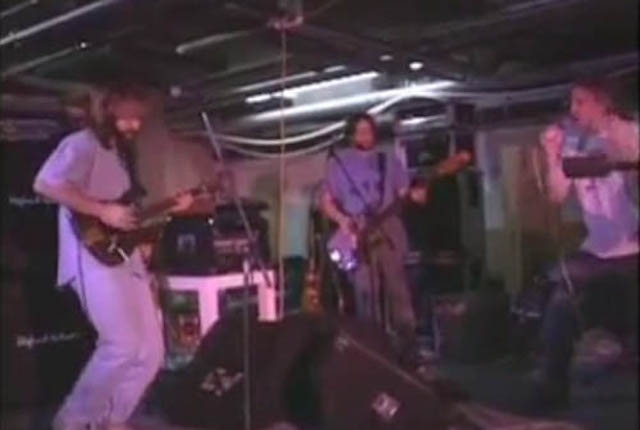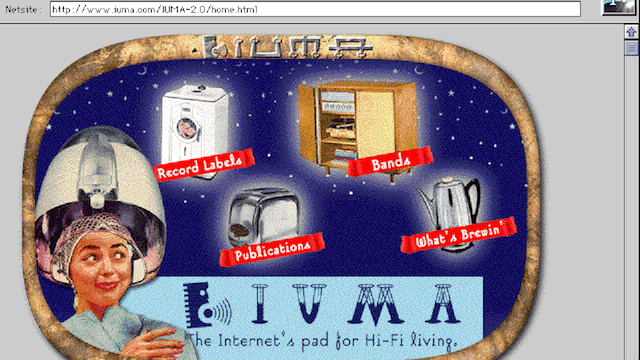Top 10 Internet Firsts That Changed Everything
The Internet has made the world a smaller place, with a far
reaching influence that’s altered the way we view cats and laugh at kids
whacked out on drugs after a trip to the dentist. But apart from giving us easier ways to cackle at dumb things, it’s also put more information at our fingertips than any invention in the history of mankind.
10. First Picture

The very first picture ever uploaded to the World Wide Web was a picture of the all-girl comedy group Les Horrible Cernettes. The group was made up of administrative assistants and partners of researchers at The European Organization for Nuclear Research (CERN). Silvano de Gennaro, the group’s manager, took the picture backstage at a music festival that was hosted annually by CERN. He Photoshopped it and saved it as a .gif file.
How this particular picture, instead of something artistic or science-based, came to be the first ever picture uploaded to the Web stemmed from the fact that de Gennaro worked at CERN near Tim Berners-Lee, inventor of the World Wide Web. When it came time to choose a picture to upload, Berners-Lee used the picture of the band because he wanted to show the heads at CERN that rather than just being a way for scientists to communicate, the Internet could also be fun. He uploaded the picture on July 18, 1992, forever immortalizing a badly photoshopped picture of a comedy band that sang jokes about science.
9. First Email

Email got its start in the early 1960s, when researchers would leave messages in a mailbox for their colleagues, who could only access the notes on the same terminal. Computer-to-computer email got its start in 1968, when Bolt Beranek and Newman (BBN) was hired by the United States Defense Department to work on ARPANET, the precursor to the Internet. A BNN employee named Ray Tomlinson started working on an experimental file transfer protocol called CYPNET and noticed that it could be used in conjunction with SNDMSG, the program designed to leave electronic messages. In doing so, he discovered he could send a message from one computer to another.
Tomlinson realized that in order to do this, he needed to have an identifier that basically equated to a mailing address. That’s when he came up with one of the most innovative, yet simple ideas of the 20th century: he chose the “@” symbol to connect the user and network, simply because it made the most sense to him. It would include the user’s name and the host where it should be sent.
In July of 1971 Tomlinson sent the first email to the computer next to his, which read, “QWERTYIOP”. After figuring out how to send messages from computer to computer, the idea flourished into the staple of everyday life that we know now.
8. First YouTube Video
The world’s third most popular website got its start in early 2005 when it was created by PayPal employees Chad Hurley, Steve Chen, and Jawed Karim. The popular story, which Karim now disputes, is that Hurley and Chen were at a dinner party and were struggling to show videos, and those difficulties planted the seed that grew into YouTube.They first registered the domain on February 14, 2005, and worked on YouTube out of a garage for a few months. On April 23, 2005, at 8:27 p.m. they posted the first video called Me at the zoo. The 19-second video features Karim standing in front of elephants at the San Diego Zoo, talking about his interest in “really, really, really long trunks.”
Since its launch, YouTube has become the dominant video streaming site and is synonymous with online videos. Only Facebook and Google are more popular websites, with YouTube receiving three billion visitors every day.
7. First Domain Name

Symbolics Inc. registered the first domain name, Symbolics.com, on March 15, 1985. Symbolics Inc. grew out of MIT’s Artificial Intelligence lab, and was the first company to make workstation computers. They were actually so far ahead of the game that “workstation computer” wasn’t even a term at that point. The company went bankrupt in the late 1980s, but the owner of the domain kept paying the dues on the website until August of 2009, when it was sold to XF.com Investments for an undisclosed price. The website is now a museum of sorts, where you can visit and learn random facts about the Internet.
6. First Website

While Symbolics was the first domain registered, it wasn’t the first website. After all, the internet and the World Wide Web are actually two different things. In the simplest terms, the Internet is what you connect to and the Web is how you view it.
You may remember CERN from the Les Horrible Cernettes photo or maybe the Large Hadron Collider, but they also launched very first website on August 6, 1991. It was a simple page, similar to a Word document with black lettering on a white background with blue hyperlinks. It briefly described project W3, better known now as the World Wide Web.
On April 30, 2013 – the 20th anniversary of the announcement of the World Wide Web – CERN announced they would re-launch the website. They found a copy that dated back to 1992, with the hopes of digging even deeper into the archives for the earliest possible version.
5. First Live Music Stream

A major difference between the advent of the World Wide Web and other mediums like the radio and television is that the Web didn’t rely on live feeds of sound or video. Instead, the Web was essentially an update of the printing press. At first it was just text, and as technology became more sophisticated the possibility for live video arose in 1993. So what music superstar of 1993 played the first online concert? Bjork? Counting Crows? Celine Dion?
Actually, it was a little-known band called Severe Tire Damage, who played live on the Internet for the first time on June 24, 1993. STD was a rock band made up of computer technologists from Digital Equipment Corp., Xerox, Apple, and Sun, giving them inside knowledge of a technology called Multicast Backbone (M-bone). M-bone utilized voice and video and was used by the Internet Engineering Task Force.
At the time, not many people saw the concert and they may not have received any recognition for their breakthrough, had it not been for The Rolling Stones. On November 22, 1994, the Stones were going to stream 20 minutes from their concert in Dallas utilizing M-bone, and the record label was promoting it as the first rock band in cyberspace. Already well versed in M-bone, STD jumped on the same stream and played before and after the Rolling Stones, a move that garnered them recognition as the first band to play live online.
4. First Item Sold on eBay

The “story” of eBay has become legendary, with its creation supposedly stemming from a programmer named Pierre Omidyar wanting to give his wife a platform to trade her Pez dispensers. Naturally, the legend is more interesting than the actual story.
In 1995, Omidyar was thinking that the web might make for a great marketplace, specifically utilizing an auction format for fair pricing on items. He launched the website AuctionWeb on September 3, 1995. The first item to sell was a broken laser pointer, which went for $14.83. Confused by someone paying for that much for a defective item, Omidyar discovered the buyer collected broken laser pointers.
Where Pez comes into the story is that, at the time Omidyar launched AuctionWeb, his future wife was big into Pez and traded a lot on AuctionWeb. Omidyar thought it was interesting that collectors were so passionate about ordinary items, obviously not realizing he was about to create a billion dollar empire on that very notion.
3. First Book Sold on Amazon

Amazon.com got its start in 1995 when founder Jeff Bezos left his position as a vice president of a Wall Street firm. He moved to Seattle and began working on his website, which he originally called Cadabra. Bezos eventually changed it to Amazon in part because Cadabra sounded too much like cadaver, but more importantly because it started with an A, meaning it would be high up on lists ordered alphabetically.
Amazon originally launched as an online book retailer, and the first book sold in July of 1995 was Fluid Concepts And Creative Analogies: Computer Models Of The Fundamental Mechanisms Of Thought, by Douglas Hofstadter. A computer scientist named John Wainwright purchased the book, and to thank him for his business, Amazon named a building on their campus after him. Man, all they ever do for us is offer lousy recommendations on bad movies.
2. First Downloadable Music

It’s hard to say definitively what the first song on the Internet was, since no one really knew what relationship the web would have with music in the early 1990s. However, it’s widely believed that the first people to put a song online were two guys named Jeff Patterson and Rob Lord. Sometime in early 1993, they uploaded some .MP2 audio files by a punk band that Lord played in called The Ugly Mugs to a file transfer protocol (FTP) portal.
The Ugly Mugs mostly played in Santa Cruz, but wanted to find a wider audience. Soon after getting their own music online, they started uploading other local bands, effectively creating the Internet Underground Music Archive (IUMA). Eventually, they had over 25,000 bands and artists, and over 680,000 songs.
The first Internet single released by a major label happened a little later in 1993, when Geffen Records released the single “Head First” by Aerosmith on the Internet in .WAV format.
1. First Banner Ad

They may be the bane of your online existence, but banner ads are essential in keeping the Internet humming along, providing revenue streams for all of those free websites you scramble to delete from your browser history.
The origin of this basic staple of the Internet and e-commerce dates back to October 27, 1994. Joe McCambley, who ran a small digital advertising company, created the first banner ad for AT&T. The all-text ad – which said “Have you ever clicked your mouse here?” – appeared on Hotwired.com, the first digital magazine. When the user clicked on it, the link took them to a site where they could do a virtual tour of seven of the world’s top museums. The idea was to show that AT&T could take you anywhere on the Internet.
source : http://www.toptenz.net/10-internet-firsts-that-changed-everything.php

0 Komentar untuk "Top 10 Internet Firsts That Changed Everything"